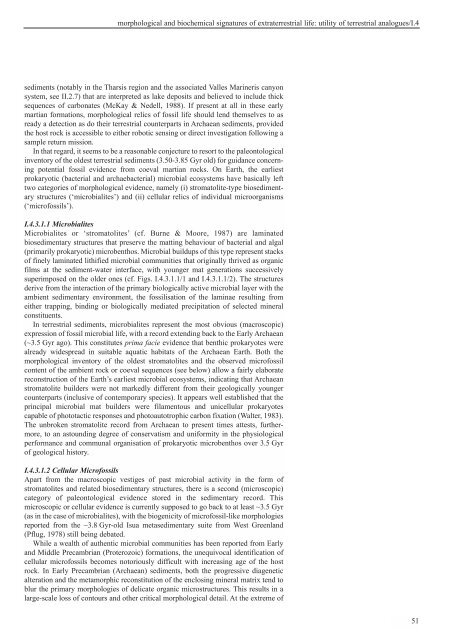Exobiology in the Solar System & The Search for Life on Mars - ESA
Exobiology in the Solar System & The Search for Life on Mars - ESA
Exobiology in the Solar System & The Search for Life on Mars - ESA
You also want an ePaper? Increase the reach of your titles
YUMPU automatically turns print PDFs into web optimized ePapers that Google loves.
morphological and biochemical signatures of extraterrestrial life: utility of terrestrial analogues/I.4<br />
sediments (notably <str<strong>on</strong>g>in</str<strong>on</strong>g> <str<strong>on</strong>g>the</str<strong>on</strong>g> Tharsis regi<strong>on</strong> and <str<strong>on</strong>g>the</str<strong>on</strong>g> associated Valles Mar<str<strong>on</strong>g>in</str<strong>on</strong>g>eris cany<strong>on</strong><br />
system, see II.2.7) that are <str<strong>on</strong>g>in</str<strong>on</strong>g>terpreted as lake deposits and believed to <str<strong>on</strong>g>in</str<strong>on</strong>g>clude thick<br />
sequences of carb<strong>on</strong>ates (McKay & Nedell, 1988). If present at all <str<strong>on</strong>g>in</str<strong>on</strong>g> <str<strong>on</strong>g>the</str<strong>on</strong>g>se early<br />
martian <str<strong>on</strong>g>for</str<strong>on</strong>g>mati<strong>on</strong>s, morphological relics of fossil life should lend <str<strong>on</strong>g>the</str<strong>on</strong>g>mselves to as<br />
ready a detecti<strong>on</strong> as do <str<strong>on</strong>g>the</str<strong>on</strong>g>ir terrestrial counterparts <str<strong>on</strong>g>in</str<strong>on</strong>g> Archaean sediments, provided<br />
<str<strong>on</strong>g>the</str<strong>on</strong>g> host rock is accessible to ei<str<strong>on</strong>g>the</str<strong>on</strong>g>r robotic sens<str<strong>on</strong>g>in</str<strong>on</strong>g>g or direct <str<strong>on</strong>g>in</str<strong>on</strong>g>vestigati<strong>on</strong> follow<str<strong>on</strong>g>in</str<strong>on</strong>g>g a<br />
sample return missi<strong>on</strong>.<br />
In that regard, it seems to be a reas<strong>on</strong>able c<strong>on</strong>jecture to resort to <str<strong>on</strong>g>the</str<strong>on</strong>g> pale<strong>on</strong>tological<br />
<str<strong>on</strong>g>in</str<strong>on</strong>g>ventory of <str<strong>on</strong>g>the</str<strong>on</strong>g> oldest terrestrial sediments (3.50-3.85 Gyr old) <str<strong>on</strong>g>for</str<strong>on</strong>g> guidance c<strong>on</strong>cern<str<strong>on</strong>g>in</str<strong>on</strong>g>g<br />
potential fossil evidence from coeval martian rocks. On Earth, <str<strong>on</strong>g>the</str<strong>on</strong>g> earliest<br />
prokaryotic (bacterial and archaebacterial) microbial ecosystems have basically left<br />
two categories of morphological evidence, namely (i) stromatolite-type biosedimentary<br />
structures (‘microbialites’) and (ii) cellular relics of <str<strong>on</strong>g>in</str<strong>on</strong>g>dividual microorganisms<br />
(‘microfossils’).<br />
I.4.3.1.1 Microbialites<br />
Microbialites or ‘stromatolites’ (cf. Burne & Moore, 1987) are lam<str<strong>on</strong>g>in</str<strong>on</strong>g>ated<br />
biosedimentary structures that preserve <str<strong>on</strong>g>the</str<strong>on</strong>g> matt<str<strong>on</strong>g>in</str<strong>on</strong>g>g behaviour of bacterial and algal<br />
(primarily prokaryotic) microbenthos. Microbial buildups of this type represent stacks<br />
of f<str<strong>on</strong>g>in</str<strong>on</strong>g>ely lam<str<strong>on</strong>g>in</str<strong>on</strong>g>ated lithified microbial communities that orig<str<strong>on</strong>g>in</str<strong>on</strong>g>ally thrived as organic<br />
films at <str<strong>on</strong>g>the</str<strong>on</strong>g> sediment-water <str<strong>on</strong>g>in</str<strong>on</strong>g>terface, with younger mat generati<strong>on</strong>s successively<br />
superimposed <strong>on</strong> <str<strong>on</strong>g>the</str<strong>on</strong>g> older <strong>on</strong>es (cf. Figs. I.4.3.1.1/1 and I.4.3.1.1/2). <str<strong>on</strong>g>The</str<strong>on</strong>g> structures<br />
derive from <str<strong>on</strong>g>the</str<strong>on</strong>g> <str<strong>on</strong>g>in</str<strong>on</strong>g>teracti<strong>on</strong> of <str<strong>on</strong>g>the</str<strong>on</strong>g> primary biologically active microbial layer with <str<strong>on</strong>g>the</str<strong>on</strong>g><br />
ambient sedimentary envir<strong>on</strong>ment, <str<strong>on</strong>g>the</str<strong>on</strong>g> fossilisati<strong>on</strong> of <str<strong>on</strong>g>the</str<strong>on</strong>g> lam<str<strong>on</strong>g>in</str<strong>on</strong>g>ae result<str<strong>on</strong>g>in</str<strong>on</strong>g>g from<br />
ei<str<strong>on</strong>g>the</str<strong>on</strong>g>r trapp<str<strong>on</strong>g>in</str<strong>on</strong>g>g, b<str<strong>on</strong>g>in</str<strong>on</strong>g>d<str<strong>on</strong>g>in</str<strong>on</strong>g>g or biologically mediated precipitati<strong>on</strong> of selected m<str<strong>on</strong>g>in</str<strong>on</strong>g>eral<br />
c<strong>on</strong>stituents.<br />
In terrestrial sediments, microbialites represent <str<strong>on</strong>g>the</str<strong>on</strong>g> most obvious (macroscopic)<br />
expressi<strong>on</strong> of fossil microbial life, with a record extend<str<strong>on</strong>g>in</str<strong>on</strong>g>g back to <str<strong>on</strong>g>the</str<strong>on</strong>g> Early Archaean<br />
(~3.5 Gyr ago). This c<strong>on</strong>stitutes prima facie evidence that benthic prokaryotes were<br />
already widespread <str<strong>on</strong>g>in</str<strong>on</strong>g> suitable aquatic habitats of <str<strong>on</strong>g>the</str<strong>on</strong>g> Archaean Earth. Both <str<strong>on</strong>g>the</str<strong>on</strong>g><br />
morphological <str<strong>on</strong>g>in</str<strong>on</strong>g>ventory of <str<strong>on</strong>g>the</str<strong>on</strong>g> oldest stromatolites and <str<strong>on</strong>g>the</str<strong>on</strong>g> observed microfossil<br />
c<strong>on</strong>tent of <str<strong>on</strong>g>the</str<strong>on</strong>g> ambient rock or coeval sequences (see below) allow a fairly elaborate<br />
rec<strong>on</strong>structi<strong>on</strong> of <str<strong>on</strong>g>the</str<strong>on</strong>g> Earth’s earliest microbial ecosystems, <str<strong>on</strong>g>in</str<strong>on</strong>g>dicat<str<strong>on</strong>g>in</str<strong>on</strong>g>g that Archaean<br />
stromatolite builders were not markedly different from <str<strong>on</strong>g>the</str<strong>on</strong>g>ir geologically younger<br />
counterparts (<str<strong>on</strong>g>in</str<strong>on</strong>g>clusive of c<strong>on</strong>temporary species). It appears well established that <str<strong>on</strong>g>the</str<strong>on</strong>g><br />
pr<str<strong>on</strong>g>in</str<strong>on</strong>g>cipal microbial mat builders were filamentous and unicellular prokaryotes<br />
capable of phototactic resp<strong>on</strong>ses and photoautotrophic carb<strong>on</strong> fixati<strong>on</strong> (Walter, 1983).<br />
<str<strong>on</strong>g>The</str<strong>on</strong>g> unbroken stromatolite record from Archaean to present times attests, fur<str<strong>on</strong>g>the</str<strong>on</strong>g>rmore,<br />
to an astound<str<strong>on</strong>g>in</str<strong>on</strong>g>g degree of c<strong>on</strong>servatism and uni<str<strong>on</strong>g>for</str<strong>on</strong>g>mity <str<strong>on</strong>g>in</str<strong>on</strong>g> <str<strong>on</strong>g>the</str<strong>on</strong>g> physiological<br />
per<str<strong>on</strong>g>for</str<strong>on</strong>g>mance and communal organisati<strong>on</strong> of prokaryotic microbenthos over 3.5 Gyr<br />
of geological history.<br />
I.4.3.1.2 Cellular Microfossils<br />
Apart from <str<strong>on</strong>g>the</str<strong>on</strong>g> macroscopic vestiges of past microbial activity <str<strong>on</strong>g>in</str<strong>on</strong>g> <str<strong>on</strong>g>the</str<strong>on</strong>g> <str<strong>on</strong>g>for</str<strong>on</strong>g>m of<br />
stromatolites and related biosedimentary structures, <str<strong>on</strong>g>the</str<strong>on</strong>g>re is a sec<strong>on</strong>d (microscopic)<br />
category of pale<strong>on</strong>tological evidence stored <str<strong>on</strong>g>in</str<strong>on</strong>g> <str<strong>on</strong>g>the</str<strong>on</strong>g> sedimentary record. This<br />
microscopic or cellular evidence is currently supposed to go back to at least ~3.5 Gyr<br />
(as <str<strong>on</strong>g>in</str<strong>on</strong>g> <str<strong>on</strong>g>the</str<strong>on</strong>g> case of microbialites), with <str<strong>on</strong>g>the</str<strong>on</strong>g> biogenicity of microfossil-like morphologies<br />
reported from <str<strong>on</strong>g>the</str<strong>on</strong>g> ~3.8 Gyr-old Isua metasedimentary suite from West Greenland<br />
(Pflug, 1978) still be<str<strong>on</strong>g>in</str<strong>on</strong>g>g debated.<br />
While a wealth of au<str<strong>on</strong>g>the</str<strong>on</strong>g>ntic microbial communities has been reported from Early<br />
and Middle Precambrian (Proterozoic) <str<strong>on</strong>g>for</str<strong>on</strong>g>mati<strong>on</strong>s, <str<strong>on</strong>g>the</str<strong>on</strong>g> unequivocal identificati<strong>on</strong> of<br />
cellular microfossils becomes notoriously difficult with <str<strong>on</strong>g>in</str<strong>on</strong>g>creas<str<strong>on</strong>g>in</str<strong>on</strong>g>g age of <str<strong>on</strong>g>the</str<strong>on</strong>g> host<br />
rock. In Early Precambrian (Archaean) sediments, both <str<strong>on</strong>g>the</str<strong>on</strong>g> progressive diagenetic<br />
alterati<strong>on</strong> and <str<strong>on</strong>g>the</str<strong>on</strong>g> metamorphic rec<strong>on</strong>stituti<strong>on</strong> of <str<strong>on</strong>g>the</str<strong>on</strong>g> enclos<str<strong>on</strong>g>in</str<strong>on</strong>g>g m<str<strong>on</strong>g>in</str<strong>on</strong>g>eral matrix tend to<br />
blur <str<strong>on</strong>g>the</str<strong>on</strong>g> primary morphologies of delicate organic microstructures. This results <str<strong>on</strong>g>in</str<strong>on</strong>g> a<br />
large-scale loss of c<strong>on</strong>tours and o<str<strong>on</strong>g>the</str<strong>on</strong>g>r critical morphological detail. At <str<strong>on</strong>g>the</str<strong>on</strong>g> extreme of<br />
51

















